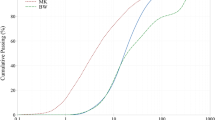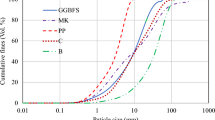Abstract
Geopolymers, known for their enhanced resistance to aggressive environment, are the subject of a new study to further increase their resistance by incorporating various raw materials. This research investigates the influence of waste glass content on the properties of alkali-activated binders exposed to an aggressive environment. The waste glass, replacing slag and metakaolin, was added in varying amounts ranging from 0 to 30 mass% . Sodium water glass, in the mass ratio of 4:5 to the binder, was used as the alkaline activator. The resistance to acid attack was assessed by immersing mortars in a sulfuric acid solution. The samples underwent analysis for appearance, mass and longitudinal change, compressive strength, and loss of alkalinity. Phase composition and microstructure were analysed using X-ray diffraction, thermogravimetric analysis, and scanning electron microscopy techniques. Acid and water leachate was analysed by inductively coupled plasma mass spectrometry. The findings of the study revealed that incorporating waste glass content up to 20 mass% reduced porosity and affected the formation of gypsum. Gypsum results from the reaction between the binder and sulfuric acid and contributes to the surface deterioration of the specimens. Consequently, this research demonstrates that waste glass incorporation in the mix design can enhance the resistance of geopolymers to sulfuric acid, thus extending the service life of concrete structures.












Similar content being viewed by others
References
Firdous R, Stephan D, Djobo JNY. Natural pozzolan based geopolymers: a review on mechanical, microstructural and durability characteristics. Constr Build Mater. 2018;190:1251–63. https://doi.org/10.1016/j.conbuildmat.2018.09.191.
Zhang Y, Gu L, Li W, Zhang Q. Effect of acid rain on economic loss of concrete structures in Hangzhou. China Int J Low-Carbon Technol. 2019;14(2):89–94.
Zhang G, Liu D, He X, Yu D, Pu M. Acid rain in Jiangsu province, eastern China: tempo-spatial variations features and analysis. Atmos Pollut Res. 2017;8(6):1031–43. https://doi.org/10.1016/j.apr.2017.02.001.
Aiken TA, Kwasny J, Sha W, Soutsos MN. Effect of slag content and activator dosage on the resistance of fly ash geopolymer binders to sulfuric acid attack. Cem Concr Res. 2018;111(June):23–40. https://doi.org/10.1016/j.cemconres.2018.06.011.
Aiken TA, Gu L, Kwasny J, Huseien GF, McPolin D, Sha W. Acid resistance of alkali-activated binders: a review of performance, mechanisms of deterioration and testing procedures. Constr Build Mater. 2022. https://doi.org/10.1016/j.conbuildmat.2022.128057.
Gu L, Bennett T, Visintin P. Sulphuric acid exposure of conventional concrete and alkali-activated concrete: assessment of test methodologies. Constr Build Mater. 2019;197:681–92. https://doi.org/10.1016/j.conbuildmat.2018.11.166.
Matalkah F, Salem T, Soroushian P. Acid resistance and corrosion protection potential of concrete prepared with alkali aluminosilicate cement. J Build Eng. 2018;20(July):705–11. https://doi.org/10.1016/j.jobe.2018.08.001.
Tome S, Nana A, Kaze CR, Djobo JNY, Alomayri T, Kamseu E, Etoh MA, Etame J, Kumar S. Resistance of alkali-activated blended volcanic Ash-MSWI-FA mortar in sulpuric acid and artificial seawater. SILICON. 2021;14:2687–94. https://doi.org/10.1007/s12633-021-01055-x.
Kaze CR, Tome S, Lecomte-Nana GL, Adesina A, Essaedi H, Das SK, Alomayri T, Kamseu E, Melo UC. Development of alkali-activated composites from calcined iron-rich laterite soil. Materialia. 2021;15:101032. https://doi.org/10.1016/j.mtla.2021.101032.
Bernal SA, Rodríguez ED, Mejía R, Gutiérrez D. Performance of alkali-activated slag mortars exposed to acids. J Sustain Cem-Based Mater. 2012;1(3):138–51. https://doi.org/10.1080/21650373.2012.747235.
Khan MNN, Kuri JC, Sarker PK. Effect of waste glass powder as a partial precursor in ambient cured alkali activated fly ash and fly ash-GGBFS mortars. J Build Eng. 2021;34:101934. https://doi.org/10.1016/j.jobe.2020.101934.
Zhang W, Yao X, Yang T, Liu C, Zhang Z. Increasing mechanical strength and acid resistance of geopolymers by incorporating different siliceous materials. Constr Build Mater. 2018;175:411–21. https://doi.org/10.1016/j.conbuildmat.2018.03.195.
Aliques-Granero J, Tognonvi TM, Tagnit-Hamou A. Durability test methods and their application to AAMs: case of sulfuric-acid resistance. Mater Struct Constr. 2017;50(1):1–14.
Lee NK, Lee HK. Influence of the slag content on the chloride and sulfuric acid resistances of alkali-activated fly ash/slag paste. Cem Concr Compos. 2016;72:168–79. https://doi.org/10.1016/j.cemconcomp.2016.06.004.
Kwasny J, Aiken TA, Soutsos MN, McIntosh JA, Cleland DJ. Sulfate and acid resistance of lithomarge-based geopolymer mortars. Constr Build Mater. 2018;166:537–53.
Elyamany HE, Elmoaty AEMA, Diab ARA. Sulphuric acid resistance of slag geopolymer concrete modified with fly ash and silica fume. Iran J Sci Technol Trans Civ Eng. 2020. https://doi.org/10.1007/s40996-020-00515-5.
Khan MNN, Kuri JC, Sarker PK. Sustainable use of waste glass in alkali activated materials against H2SO4 and HCl acid attacks. Clean Eng Technol. 2022;6:100354. https://doi.org/10.1016/j.clet.2021.100354.
Burciaga-Díaz O, Durón-Sifuentes M, Díaz-Guillén JA, Escalante-García JI (2020) Effect of waste glass incorporation on the properties of geopolymers formulated with low purity metakaolin. Cem Concr Compos. 107
Kubatova D, Kotlanova MK, Khongova I, Zezulova A, Bohac M. Use the waste glass for the synthesis of geopolymer-zeolite composites. J Phys Conf Ser. 2022;2341(1):012012.
Ilić BR, Mitrović AA, Miličić LR. Thermal treatment of kaolin clay to obtain metakaolin. Hem Ind. 2010;64(4):351–6.
Rocha J, Klinowski J (1990) Solid‐State NMR studies of the structure and reactivity of metakaolinite. Angew Chemie Int Ed English. 29(5)
Zivica V, Palou MT, Bágeľ TIĽ. High strength metahalloysite based geopolymer. Compos Part B Eng. 2014;57:155–65.
Yao X, Zhang Z, Zhu H, Chen Y. Geopolymerization process of alkali-metakaolinite characterized by isothermal calorimetry. Thermochim Acta. 2009;493(1–2):49–54.
Chithiraputhiran S, Neithalath N. Isothermal reaction kinetics and temperature dependence of alkali activation of slag, fly ash and their blends. Constr Build Mater. 2013;45:233–42. https://doi.org/10.1016/j.conbuildmat.2013.03.061.
Mohamed R, Abd Razak R, Abdullah MMAB, Abd Rahim SZA, Yuan-Li L, Subaer, et al (2022) Heat evolution of alkali-activated materials: a review on influence factors. Constr Build Mater. 314
Zhang S, Keulen A, Arbi K, Ye G. Waste glass as partial mineral precursor in alkali-activated slag/fly ash system. Cem Concr Res. 2017;102:29–40. https://doi.org/10.1016/j.cemconres.2017.08.012.
Granizo M, Blanco MT (1998) Alkaline activation of metakaolin. J Therm Anal. pp 957–65
Gu L, Visintin P, Bennett T. Evaluation of accelerated degradation test methods for cementitious composites subject to sulfuric acid attack; application to conventional and alkali-activated concretes. Cem Concr Compos. 2018;87:187–204. https://doi.org/10.1016/j.cemconcomp.2017.12.015.
Samarakoon MH, Ranjith PG, De Silva VRS. Effect of soda-lime glass powder on alkali-activated binders: Rheology, strength and microstructure characterization. Constr Build Mater. 2020;241:118013. https://doi.org/10.1016/j.conbuildmat.2020.118013.
Gao X, Yu QL, Brouwers HJH. Reaction kinetics, gel character and strength of ambient temperature cured alkali activated slag-fly ash blends. Constr Build Mater. 2015;80:105–15.
Chaipanich A, Wianglor K, Piyaworapaiboon M, Sinthupinyo S. Thermogravimetric analysis and microstructure of alkali-activated metakaolin cement pastes. J Therm Anal Calorim. 2019;138(3):1965–70. https://doi.org/10.1007/s10973-019-08592-z.
Khan MZN, Shaikh F, uddin A, Hao Y, Hao H,. Synthesis of high strength ambient cured geopolymer composite by using low calcium fly ash. Constr Build Mater. 2016;125:809–20. https://doi.org/10.1016/j.conbuildmat.2016.08.097.
Tommasini Vieira Ramos FJH, de Fátima Marques Vieira M, Tienne LGP, de Oliveira Aguiar V,. Evaluation and characterization of geopolymer foams synthesized from blast furnace with sodium metasilicate. J Mater Res Technol. 2020;9(5):12019–29. https://doi.org/10.1016/j.jmrt.2020.08.019.
Wang Y, Cao Y, Zhang Z, Huang J, Zhang P, Ma Y, et al. Study of acidic degradation of alkali-activated materials using synthetic C-(N)-A-S-H and N-A-S-H gels. Compos Part B Eng. 2022;230:109510. https://doi.org/10.1016/j.compositesb.2021.109510.
Aly Z, Vance ER, Perera DS, Hanna JV, Griffith CS, Davis J, et al. Aqueous leachability of metakaolin-based geopolymers with molar ratios of Si/Al = 1.5–4. J Nucl Mater. 2008;378(2):172–9.
Allahverdi A, Skvara F. Sulfuric acid attack on hardened paste of geopolymer cements Part 1.Mechanism of corrosion at relatively high concentrations. Ceram-Silik. 2005;49(4):225–9.
Komljenović MM, Baščarević Z, Marjanović N, Nikolić V. Decalcification resistance of alkali-activated slag. J Hazard Mater. 2012;233–234:112–21.
Ahmad MR, Chen B, Shah SFA. Influence of different admixtures on the mechanical and durability properties of one-part alkali-activated mortars. Constr Build Mater. 2020;265:120320. https://doi.org/10.1016/j.conbuildmat.2020.120320.
Acknowledgements
This research was carried out within project No. 23-05122S, financed by the Czech Science Foundation.
Author information
Authors and Affiliations
Contributions
The authors confirm contributions to the paper as follows: study conception and design: DK; material preparation: DK; data collection and analysis: DK, MKK, IK; interpretation of results: DK, AZ, MB; draft manuscript preparation: DK, AZ, MB. All authors reviewed the results and approved the final version of the manuscript.
Corresponding author
Additional information
Publisher's Note
Springer Nature remains neutral with regard to jurisdictional claims in published maps and institutional affiliations.
Rights and permissions
Springer Nature or its licensor (e.g. a society or other partner) holds exclusive rights to this article under a publishing agreement with the author(s) or other rightsholder(s); author self-archiving of the accepted manuscript version of this article is solely governed by the terms of such publishing agreement and applicable law.
About this article
Cite this article
Kubatova, D., Zezulová, A., Khongová, I. et al. Effect of waste glass content on resistance of geopolymer binders to sulfuric acid attack. J Therm Anal Calorim 148, 13011–13026 (2023). https://doi.org/10.1007/s10973-023-12332-9
Received:
Accepted:
Published:
Issue Date:
DOI: https://doi.org/10.1007/s10973-023-12332-9




